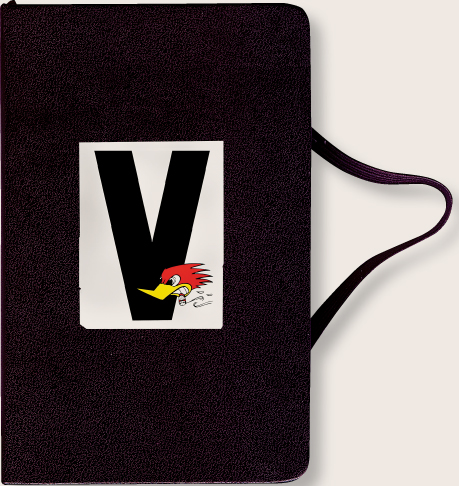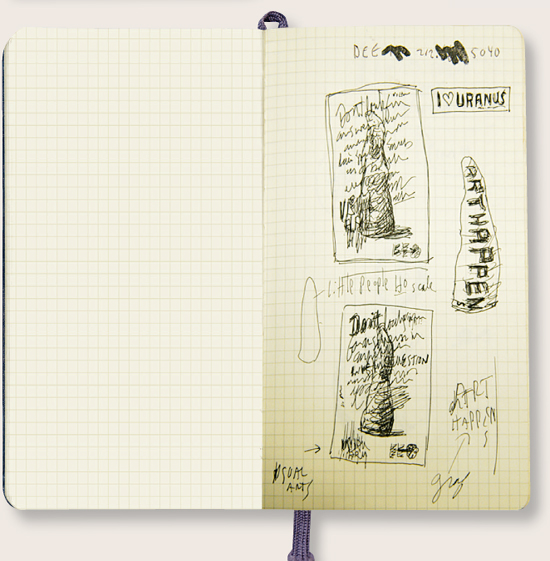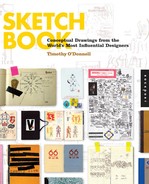“Computers have allowed students to go straight to step two: execution. But too many of them have no idea of step one: thinking.”
JAMES VICTORE is a self-taught, independent graphic designer whose work includes publishing, posters, and advertising for numerous clients, including Moët & Chandon and the New York Times. His posters are in the permanent collections of the Palais du Louvre, Paris, and the Library of Congress, Washington, D.C. He teaches graphic design at the School of Visual Arts in New York City and is a member of the Alliance Graphique Internationale (AGI).
Q+A/ James Victore /
James Victore, Inc.
Brooklyn, New York
Q How do you sketch? Is it mainly stream-of-consciousness doodling, or is it more purposeful, problem-solving sketching?
A I sketch constantly. My sketches are not doodles, nor are they technical drawings. They are a shorthand, an external thinking process. I rarely sketch in the studio. What is most useful is to leave the studio with my sketchbook and a few pens and go ruminate on a project. Bars and restaurants are very useful. Airplanes work very well, too.
Sketching, for me, is a huge part of my process. Usually the sketch has all the bits and elements of the final work—even in the right proportions. All I have to do is follow the sketch. Sometimes we just break down and use the sketch as final.
Q What do you think the importance of sketching is in an art education? Do you encourage your students to do more of it?
A No, I never encourage my students to sketch. They need to find their own way, sketching included. I cannot impose my way of thinking or technique on anyone.
Q Have you noticed a shift in the way your students approach projects, how they nurture ideas and bring them to fruition, as the field has become computerized? I’m thinking of how accelerated everyone’s lives have become, coupled with the overwhelming amount of visual information we all have to process. What can sketches do that working directly onto the computer can’t accomplish?
A Good question. Computers have allowed students to go straight to step two: execution. But too many of them have no idea of step one: thinking. Sketching and drawing are important tools for a designer. It is a way of training your mind. It is like learning to play a sport, but not having any hand-eye coordination you will go through the motions of something that looks like a sport, or be very technical about it, but not actually be very good at it. I see soooo much work out there that is done by designers who can’t draw. You can tell. And what’s worse, real human beings can tell. They sense it without knowing. They feel it. This kind of work robs us of our daily beauty. Designers make art for the street, whether they own up to that responsibility or not. And drawing is the basis of it all. Always has been.
Q Do you show clients sketches before proceeding to a finished piece? Or do you see your sketches as private property?
A My sketchbooks are ugly. They are how I think, and they are very private. I like to show clients something rough—but not that rough. I think my clients would be shocked at viewing my sketchbooks.
Q Do you ever complete a project and feel the sketch was more successful than the ultimate solution?
A Always.
Q Why do you think this is?
A The reason is: I am not thinking when I sketch. I try not to think like a designer to begin with, but in my sketchbook my thoughts are very free, and trying to reign in that freedom and keep it fresh is difficult.
Q This passage from Ayn Rand’s The Fountainhead resonated with me:
He found himself suddenly in his glass-enclosed office, looking down at a blank sheet of paper—alone. Something rolled in his throat down to his stomach, cold and empty . . . .
He leaned against the table, closing his eyes. It had never been quite real to him before that this was the thing actually expected of him—to fill a sheet of paper, to create something on a sheet of paper.8
Q Hopefully not to the degree in the above quote, but do you ever feel nervous approaching a blank piece of paper?
A Always. One of my mentors told me, “The paper is as free as the canvas.” This was not a freeing idea. It rather scared the crap out of me. All beginnings are hard.


The sketchbooks of designer Aimee Sealfon

